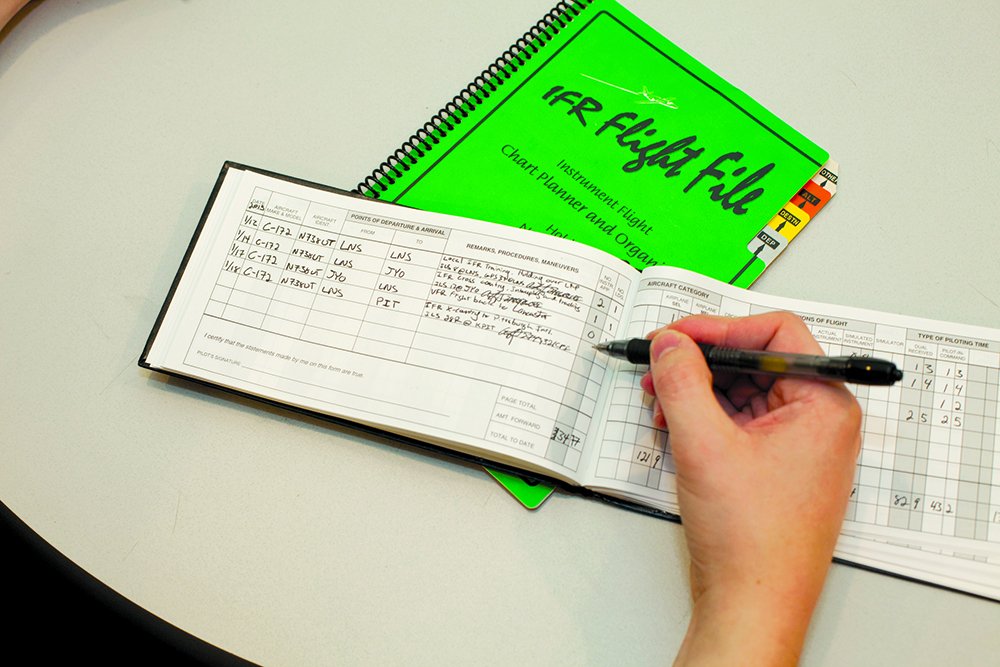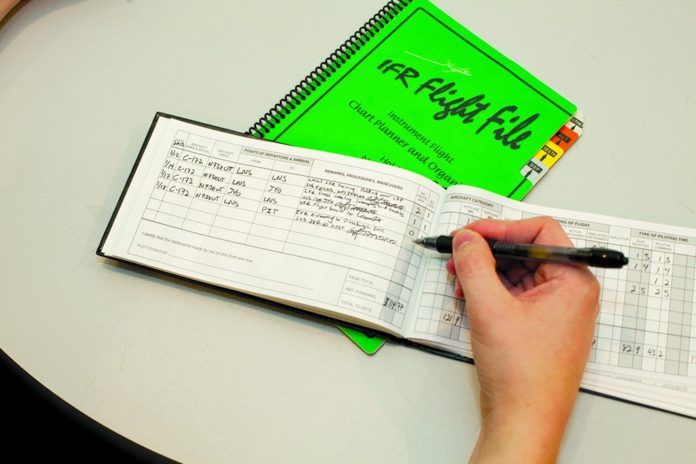Within the IFR community, there has been much confusion over how and when to log instrument approaches. The FAA extended that confusion to logging approaches in a simulator as we wrote in the December issue, “Need a Sim Instructor?”
Letters of Authorization for ATDs have approved their use to meet 61.57(c) for instrument currency. However, unlike in an airplane where you fly it and log it, 61.51(g) requires an authorized instructor to observe and to sign off.
Who is an authorized instructor is buried in 61.193, which requires an instructor who “is authorized within the limitations of that person’s flight instructor certificate and ratings to train and issue endorsements” for, among other things, recency of experience. An FAA interpretation (Griffith, 2008) makes clear that a CFII is required to endorse an instrument proficiency check. It stands to reason that a CFII would be required to endorse a logbook for proficiency as well.
After all the back-and-forth, the FAA issued a definitive Information For Operators, InFO 15012, on September 8, 2015. Subject: Logging Instrument Approach Procedures. The InFO clarifies the conditions under which you can log an approach for both maintaining proficiency in general and for instrument practical tests and IPCs as well. You can find it on the web; it’s worth dissecting here.
Adam Wright
Actual, Hooded Or In the Sim
Per 61.57(c), instrument currency experience can be gotten in four different ways. First, you can actually fly in IMC. The second lets you use a view-limiting device with a safety pilot in an airplane. The third way is to use a flight simulator of any of the various types. The fourth way uses complex combinations of the first three, per 61.57(c)(4) and (5).
It’s important to note that if you use an ATD exclusively, you get only two months’ currency, not six. In addition to the six approaches, holding, intercepting and tracking and three hours of instrument experience, you must also accomplish two unusual attitude recoveries in a descending Vne condition and two more in an ascending stall-speed condition. See 61.57(c)(3).
Four Conditions
You can log an approach for currency or training purposes when the conditions below are met.
1. Whether conducted in an aircraft, flight simulator, FTD or ATD, you must operate it solely by reference to instruments per 61.51(g)(1).
2. In an airplane or any sim, you must be established on each required segment (see below) of the IAP down to minimums. This was established via an FAA legal interpretation (Murphy, 2009; Slater, 1992). Don’t panic, see item five.
3. Simulated conditions, when used, must continue to minimums.
4. Flight in an aircraft must be conducted under actual or simulated IMC in accordance with 61.51(g)(1). During simulated conditions, you can deviate from the final approach segment for reasons of safety such as traffic. You may still log the approach once you’ve passed the final approach fix.
5. The approach can be logged if you are flying an aircraft in actual IMC, and the aircraft transitions from IMC to VMC within the final approach segment of the IAP before or upon reaching minimums. The FAA does not require the ceiling to be at or below minimums when in actual IMC, so you don’t have to find the right (wrong?) weather. You will hopefully transition from IMC to VMC and meet the conditions for landing specified in 91.175. You need not actually land. If you are still IMC, perform the missed approach at the MAP. Either way, you can log the approach.
Required Segments
You must fly a complete approach beginning either at an IAF or via an associated feeder route. You must fly the initial, intermediate and final approach segments as defined in AIM 5-4-7(e). You can be radar vectored to the final approach course by ATC. Alternatively, a safety pilot, authorized instructor or an FAA designee such as an examiner, can simulate ATC vectoring.
You need not fly the missed-approach segment, although the FAA recommends doing so for proficiency, and I think most instructors would agree.
Learning by Example, Case I
You, the instrument-rated and current pilot, are flying on an IFR clearance in the soup. You are lined up with the runway about 15 miles from the airport. ATC clears you for the straight-in ILS approach as published. Maintain 2500 and report established.
Operating solely by instruments, you comply with the clearance and continue in IMC. You report established and remain so for the initial, intermediate and final approach segments. Before the final approach fix, you are told to contact the tower, who clears you to land. You break into VMC after the FAF but before reaching decision altitude. You visually confirm that you have the runway environment in sight and land.
The approach conforms to 61.51(g), Logging Instrument Time, because you can log instrument flight time while you operated the aircraft solely by reference to instruments in actual conditions. You also meet 61.57(c), Instrument Experience, since you’re instrument current.
Case II
You’re a Private Pilot working on your instrument rating. You and your instructor are in VMC, returning from an IFR training flight that will end as you fly a published IAP. You’re wearing a view-limiting device, and therefore operating the aircraft solely by instruments. You brief the instructor on the approach. Shortly afterward, the CFII gives you simulated ATC vectors to the final approach course: “Skyhawk 44939 is three miles outside STANE (the FAF), maintain two thousand until established, cleared localizer Runway six approach. Report established inbound.”
You comply, establish yourself on the intermediate segment and proceed to the FAF and then establish yourself on the final approach segment, simulating IMC right down to the MDA per your instructor’s direction. Crossing the FAF, the tower clears you to land. At MDA you look outside, confirm runway environment in sight, and make a greaser landing (of course).
The message in this case is that, being simulated, you had to fly the approach to MDA in simulated conditions in order for it to count. You have complied with 61.51(g), Logging Instrument Time.
Had any portion of the flight been IMC, your instructor could have logged both the time and the IMC approach because he supervised all of it per 61.51(g)(2). The approach is considered to meet the obligation of 61.57(c)(1) for logging purposes per an FAA interpretation (Levy, 2008).
Case III
You’ve finally earned that coveted instrument rating. You and your qualified safety-pilot buddy are IFR in VMC; you’re under the hood. Approaching the airport, you run the checklist and request ATC for “own navigation for the VOR 8R approach.” The controller thinks it over and issues, “Proceed direct SKYGO (an initial approach fix), hold as published; maintain 4000. Advise established.”
After digging to recall how to hold, you do it and report established. After a couple turns, you get, “Cleared VOR 8R approach. Advise established inbound.”
Remaining established on each segment, and staying on the gauges, you reach MDA and eventually the MAP. Removing the hood, you find the runway laid out before you like a welcome mat. To your surprise, your soon-to-be ex-buddy snaps the hood back on you and tells you to fly the published missed. You do so perfectly, just to spite him. You later thank him for pressing you a little harder. You’re not just buddies again; you can log this approach because you met the terms of 61.51(g) and 61.57(c).
Evaluating InFO 15012
This InFO succeeded in clarifying just what the FAA expects in order to legally log approaches. It is consistent with Office of Chief Counsel interpretations as annotated above. Better, it conforms to general common sense, as in considering an approach past the FAF in actual, sufficient to demonstrate proficiency. We can finally put this bucket of ambiguities behind us to sally forth and commit (and log) IFR safely and legally.

Fred Simonds is a Gold Seal CFII in Florida. See his web page at www.fredonflying.com.






Excellent article!
Updates were made in 2018. The ‘2 month’ ATD restriction is gone. Additionally, they now allow instrument-rated pilots to use a BATD without a CFII present when logging approaches for currency.
I think this article needs updating again. In the latest FARs, sections 61.57(c)(4) and (5) do not exist, and 61.57(c)(3) is titled, “Maintaining instrument recent experience in a glider.”
This article is way off. Please review and update.
Made my heart skip a beat when I first read the article, then I saw the date…. Definitely needs an update.
this article is woefully out of date and does not reflect the current FARs
The article is well structured but outdated.
Please update and republish.
It’s inexcusable that this article is sent out to pilots. The FAA makes it difficult enough for us to keep track of the requirements and the sometimes obtuse FAA interpretation of the requirements. Apparently, IFR magazine never learned that negative training is never a good thing.
I completely agree! Absolutely inexcusable. I started searching the FARs after reading this and couldn’t find any reference to the mysterious “2 month” rule. I eventually noticed the date on this, but it’s really disappointing that this got sent out when it’s so out of date and wrong.
Sadly, as a new subscriber, this article will likely make me question much of what I read in this magazine.